Plantings promote fight against desertification
Rural workers rely on drought-resistant species to curb sand spread in Gansu, Inner Mongolia


Success with saxaul
In Alshaa Left Banner, Inner Mongolia autonomous region, former herder Pan Duoyun has discovered that planting saxaul trees, a drought-resistant species, not only gives local farmers and herdsmen an effective tool to combat desertification, but also helps sustain their livelihoods.
"Realizing the severity of desertification, the local government relocated all our herders to the town," said Pan, Party secretary of Bayanwula village in Alshaa. "Although the living conditions seemed to have improved, we were not used to the new environment, and the cost of living was very high. However, we had no choice but to stay, as we could no longer pursue our traditional livelihood of grazing."
In 2012, the 62-year-old planted saxaul in an experimental area spanning 2,000 sq m and later grafted highly valued Cistanche onto them. Cistanche is a traditional herb with adaptogenic properties that may improve brain function, boost immunity, slow aging and treat infertility.
Pan's experiment proved successful and inspired many herdsmen to return to the village. The subsidies offered by the local government and charitable organizations such as the Society of Entrepreneurs & Ecology Foundation serve as significant incentives, especially considering the relatively lengthy time it takes to yield benefits. The parasitic Cistanche plant reaches its peak medicinal value after growing for three years.
"A one-mu (one-fifteenth of a hectare) field can now yield more than 300 kilograms of Cistanche, with a selling price ranging from 30 to 40 yuan per kilogram," Pan said, adding that other drought-resistant plants are also cultivated locally, fulfilling residents' desire to improve the environment and create wealth in their hometown.
"The field used to feed our flocks and herds, and we are committed to doing our utmost to conserve it," he said.
limenghan@chinadaily.com.cn























